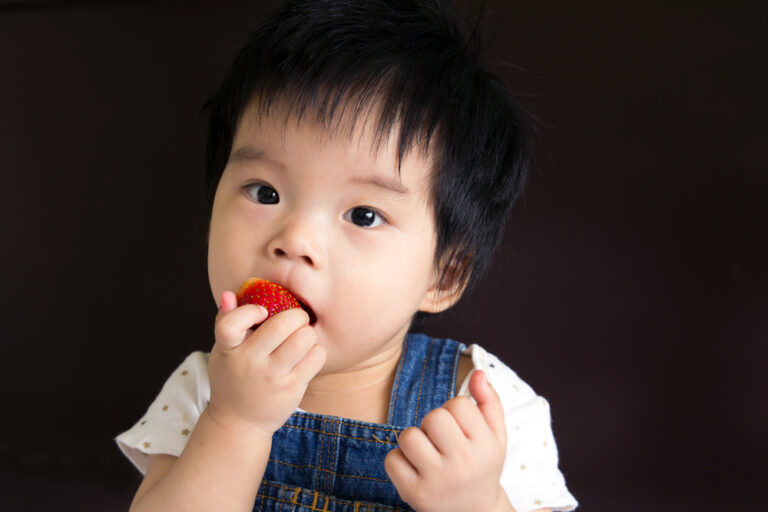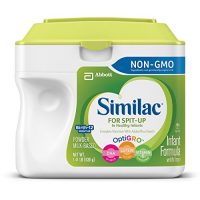Once you start giving your baby solid foods at 6 months, they can try strawberries for the first time. As with all foods, it’s important to go at your baby’s pace when offering new food. Strawberries are delicious, and your little one will likely enjoy the sweet snack. As with all foods, ensure you are following standard guidelines to help your baby eat safely.
Things to Consider
As with all solids, it’s important to wait until your baby is 6 months old before you start offering strawberries for the first time. At this point, your baby has better head and neck control and will have an easier time eating. Here are some helpful considerations when it comes to offering strawberries for the first time.
Buy Organic
It’s no secret that organic foods are not the cheapest option, and if it doesn’t fit in your price point, that is ok. However, conventionally grown strawberries tend to have a higher concentration of pesticides than those grown organically. Unfortunately, strawberries land at the top of the list of the “dirty dozen.”
If you do not buy organic strawberries, ensure you thoroughly clean the fruit before offering them to your child. Keep in mind that some non-organic fruits and vegetables are not as prone to pesticides, like avocados and broccoli, so you don’t have to go the organic route all the time.
Finally, consider growing your own strawberries! You can easily buy a strawberry plant at the local home improvement store and grow your own fruit. They are quickly growing, so you’ll be able to reap the benefits in no time.
Freeze Leftover Strawberries
Unfortunately, strawberries can start to go bad within just a few days. If you have any leftover strawberries after 2-3 days, I recommend freezing them and throwing them into a smoothie another day. It’s ideal to freeze them in a single layer on a cookie sheet and then throw them into a bag together.
In addition, cut off the stems before you freeze the strawberries. This way, you can put them directly into a blender when you are ready to use them. Keeping the strawberries whole when you freeze them helps preserve the essential Vitamin C.
Avoid Underripe Strawberries
Strawberries don’t ripen once they are picked. What you get is what you get. Therefore, any underripe strawberries will be harder and more difficult for babies to eat. In addition to the potential choking hazard, they don’t taste as good as ripe strawberries.
As a note, your baby’s diaper change may look a little different after they have eaten strawberries. All babies don’t digest the seeds in strawberries, and you may find the surprise in their diapers. Thankfully, there is nothing to worry about, except for a strange diaper, of course.
Health Benefits of Strawberries
As with most berries, strawberries have some exceptional health benefits. They are full of Vitamin C, which is ideal for your baby’s ever-developing immune system.
In addition, Vitamin C helps better absorb iron into your baby’s body. Strawberries are best served alongside foods like beans and meat to help with absorption. Leafy greens, like spinach, are another exceptional option to serve with strawberries.
Finally, like most berries, strawberries are loaded with antioxidants and keep your little one’s cells healthy. Strawberries are also a solid source of fiber, which will help move things along in their digestive tract.
Best Ways to Prepare Strawberries for Babies
There are several ways you can prepare strawberries for your little one. It’s best to follow their lead on what works best. Remember, you can always change how you serve strawberries as your little one grows and gets more accustomed to eating.
Pureed Strawberries
If your baby is eating purees, you can easily puree up some delicious strawberries for them. Simply blend them up until they are smooth. Your baby is likely eating other fruits and vegetables at this point so that you can mix the pureed strawberries with other purees.
Some of my favorite combinations include mixing strawberries with bananas or apples. Simply puree the fruit together as you normally would and serve it to your baby with a spoon. We have a list of the best baby spoons if you are in the market for a new one.
Finally, if you have begun serving your baby oatmeal or cereal, you can mix the strawberry puree with those foods. It’s a way to sweeten up the sometimes bland foods.
Sliced Strawberries
If you follow the baby-led weaning plan, then simply slice up the strawberries for some tasty finger foods. Strawberries are fairly soft foods, so babies won’t have trouble using their cute, gummy mouth to eat them. When your baby is first trying strawberries, I recommend cutting them into thin slices.
As your baby gets older, you can begin cutting them into small chunks, making it easier for them to pick up using their pincher grasp or using a fork. If the berries are large, you can offer them whole to your baby, sans the stem. Be sure to keep an eye on your child so they don’t bite off any large pieces.
Strawberry Smoothie
There’s nothing quite like a cool strawberry smoothie on a hot day. Throwing some frozen strawberries, chunks of banana, and some breastmilk into the blender makes for a great treat for your little one. While little hands won’t hold a cup, they can work on drinking through a straw.
You can easily substitute the breastmilk for yogurt or almond milk. As a reminder, babies under one should not be given cow’s milk. If your baby has already had a good variety of fruits and veggies, feel free to add others to the mix. I always seemed to find a way to sneak some greens into what I fed my kiddos.
FAQs – Babies and Strawberries
Can a baby be allergic to strawberries?
It used to be recommended to wait until babies were at least 12 months old before offering strawberries for the first time. They were a food that fell into the common allergy category. However, it was determined that waiting to offer the fruit had no protective benefit to the child.
If your baby develops a rash around their mouth after eating strawberries, it doesn’t necessarily mean they are allergic. The acidic fruit can leave a rash around their mouth, especially since babies get a lot of food on their faces.
In addition, if you feel your baby has had an allergic reaction to strawberries, it’s important to contact your pediatrician to discuss the issue further.
I, personally, thought my oldest son was allergic to strawberries when he was a few years old. It seemed like his face and hands always were irritated after eating the fruit. I ended up getting him an allergy test where they confirmed there was no allergy. Unfortunately, the delicious fruit can be somewhat of an irritant when the juices get on your skin.
Finally, a true allergic reaction to strawberries would present itself with swelling around a child’s mouth and lips and hives. Do not hesitate to seek medical assistance if your child has such a reaction.
Can babies choke on strawberries?
Any large chunks of strawberries can become a choking hazard to babies. In fact, strawberries are considered a common choking hazard. It’s best to start with small pieces of the fruit to ensure your baby has no trouble eating them.
You can gradually increase the size of pieces you offer your little one as they get older and do better with chewing. Since strawberries do vary in size, it’s important to gauge how much cutting you should do on the size of fruit you have.
Finally, it’s important to have your baby in a high chair while feeding them. It ensures they stay upright and can’t wiggle around. If you haven’t found the perfect one yet, we have a list of the best high chairs for babies.
Final Thoughts
I fondly remember going strawberry picking as a child and love doing it with my kids now. As a parent, I wondered, “when can a baby have strawberries?” because I was ready to share the delicious fruit with my kiddos.
Just like with all foods, it’s important to wait until your baby is 6 months old before offering strawberries for the first time. At this point, they are sitting up for longer periods of time and have stellar neck control. Both of these developmental milestones help babies to eat more properly and safely.






